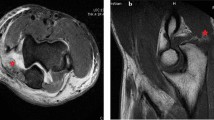Abstract
Background
Ligamentous injury associated with isolated coronoid fracture had been sparingly reported. Concealed or unclear fractures and ligamentous or articular cartilage lesions are promptly acknowledged by magnetic resonance imaging (MRI) but cannot be entirely pictured in regular radiological assessments. In isolated coronoid fracture, the fragment size is very small and due to the complex anatomy surrounding the coronoid radiographic imaging may not be sufficient. The purpose of this study was to evaluate the incidence of combined osteochondral and ligamentous injuries by magnetic resonance imaging (MRI) in 24 patients with an isolated coronoid fracture.
Materials and Methods
In a retrospective study conducted at tertiary hospital between 2009 and 2011, elbow radiographs (anteroposterior and lateral views), computed tomography scan images, and MRI in the sagittal, coronal, axial, oblique, and coronal oblique planes were collected and reviewed. Musculoskeletal radiologist with subspecialty training in musculoskeletal MR interpretation and a fellowship-trained shoulder and elbow surgeon evaluated the MRI.
Results
The incidence of associated injuries revealed torn lateral collateral ligament (LCL) in all 24 patients (100%) while 15 patients (62.5%) had common extensor muscle tears. Seven of 24 elbows (29.2%) showed medial collateral ligament (MCL) tear, and 13 of 16 patients (81.3%) with anteromedial facet fracture had MCL attached to the fragment. Five of 24 (20.8%) cases had contusions on the radial head. On the distal humeral side, 15 patients had bone contusions on the posterior inferior of the trochlear on sagittal view. The ligament affections of the LCL were confirmed intraoperatively and repaired.
Conclusion
LCL injury was consistent in all isolated coronoid fracture. The forces resulting in the injury appear similar to varus distraction forces acting in the knee leading to distraction injuries of the lateral structures of the knee joint. As concurrent osteochondral injuries and ligamentous injuries are not rare, magnetic resonance analysis serves as an excellent tool for analysis of the ligamentous injuries preoperatively and aids in surgical planning.
Similar content being viewed by others
References
Regan W, Morrey B. Fractures of the coronoid process of the ulna. J Bone Joint Surg Am 1989;71:1348–54.
O’Driscoll SW, Jupiter JB, Cohen MS, Ring D, McKee MD. Difficult elbow fractures: Pearls and pitfalls. Instr Course Lect 2003;52:113–34.
Steinmann SP. Coronoid process fracture. J Am Acad Orthop Surg 2008;16:519–29.
Fitzpatrick MJ, Diltz M, McGarry MH, Lee TQ. A new fracture model for “terrible triad” injuries of the elbow: Influence of forearm rotation on injury patterns. J Orthop Trauma 2012;26:591–6.
Mirowitz SA, London SL. Ulnar collateral ligament injury in baseball pitchers: MR imaging evaluation. Radiology 1992;185:573–6.
Itamura J, Roidis N, Mirzayan R, Vaishnav S, Learch T, Shean C. Radial head fractures: MRI evaluation of associated injuries. J Shoulder Elbow Surg 2005;14:421–4.
Carrino JA, Morrison WB, Zou KH, Steffen RT, Snearly WN, Murray PM. Lateral ulnar collateral ligament of the elbow: Optimization of evaluation with two-dimensional MR imaging. Radiology 2001;218:118–25.
Gómez Navalón LA, ZorrillaRibot P, Salido Valle JA. Isolated fracture of the coronoid process. Acta Orthop Belg 2005;71:615–7.
Davidson PA, Moseley JB Jr, Tullos HS. Radial head fracture. A potentially complex injury. Clin Orthop Relat Res 1993;297:224–30.
Hill NB Jr, Bucchieri JS, Shon F, Miller TT, Rosenwasser MP. Magnetic resonance imaging of injury to the medial collateral ligament of the elbow: A cadaver model. J Shoulder Elbow Surg 2000;9:418–22.
Kaplan LJ, Potter HG. MR imaging of ligament injuries to the elbow. RadiolClin North Am 2006;44:583–94, ix.
O’Driscoll SW, Morrey BF, Korinek S, An KN. Elbow subluxation and dislocation. A spectrum of instability. Clin Orthop Relat Res 1992;280:186–97.
Potter HG, Weiland AJ, Schatz JA, Paletta GA, Hotchkiss RN. Posterolateral rotatory instability of the elbow: Usefulness of MR imaging in diagnosis. Radiology 1997;204:185–9.
Pollock JW, Pichora J, Brownhill J, Ferreira LM, McDonald CP, Johnson JA, et al. The influence of type II coronoid fractures, collateral ligament injuries, and surgical repair on the kinematics and stability of the elbow: An in vitro biomechanical study. J Shoulder Elbow Surg 2009;18:408–17.
Author information
Authors and Affiliations
Corresponding author
Rights and permissions
About this article
Cite this article
Kekatpure, A.L., Aminata, I.W., Jeon, IH. et al. Isolated coronoid fracture: Assessment by magnetic resonance imaging for concomitant injuries. IJOO 50, 311–315 (2016). https://doi.org/10.4103/0019-5413.181792
Published:
Issue Date:
DOI: https://doi.org/10.4103/0019-5413.181792




